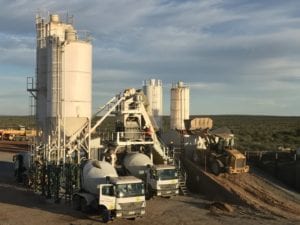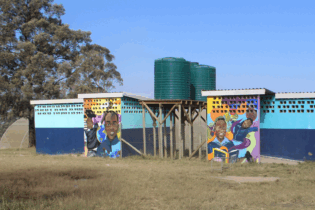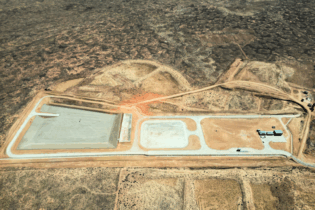As of 30 January 2019, a new source of solar power is boosting Eskom’s national grid from the Northern Cape town of Kathu, where a R12 billion generation plant has achieved commercial operation, following two years of construction that saw almost 65 000 m3 of concrete poured.
Based on concentrated solar power (CSP) technology, Kathu Solar Park is adding 100 MW to Eskom’s capacity – enough to supply 179 000 homes in the local community of John Taolo Gaetsewe District Municipality, Northern Cape, and South Africa as a whole, with clean and reliable energy. The project, developed by a consortium of local and international stakeholders, is part of the Renewable Energy Independent Power Producer Procurement Programme (REIPPPP) being implemented by the Departmentof Energy. The CSP plant uses parabolic troughs, designed like curved mirrors, to direct and focus the sun’s energy on to an absorber pipe containing a heat-absorbing medium that carries the energy to the water in a boiler heat exchanger. Here, the heat is used to produce steam, which in turn drives turbines to generate electricity. As one of the largest such plants in South Africa, it covers a footprint of 4.5 km², over which 384 000 mirrors have been installed. To make optimal use of the sun’s energy over the course of each day, a tracking system on each solar collector assembly makes sure that the sun’s rays are always focused on the absorber pipe. Using molten salt as a way of storing energy gives the system an extra 4.5 hours of thermal energy storage when the sun is not shining, so the plant can generate power for 16 to 18 hours a day.
EPC phases
The construction process began in May 2016, driven by a consortium formed by Acciona in partnership with Sener, which acted as the engineering, procurement and construction provider. Cement for the structures and foundations came from construction materials leader AfriSam, which supplied Kuruman-based contractor Agisane Civil Construction with all readymix requirements. To meet the varying applications on the project,19 different concrete mixes were used. Much of the concrete was used for piling and the bases of the support structures for the thousands of parabolic reflectors, as well as for the foundations and supports for the large process elements in the project’s ‘power block’, at the centre of the solar field. These elements included bases for turbines, salt tanks, towers and storage vessels. For the reflector stands, about 40 000 reinforced piles were poured, with each stand foundation requiring four piles to a depth of 2 m to 8 m. Where soils were collapsible, making them unsuitable for piling, raft foundations were used. The pit and towers for the storage area of the heat transfer fluid (HTF) system were another significant collection of concrete structures. Vessel tanks containing the HTF, which circulates through the solar fields to keep the salt molten, are held on concrete towers standing in a large concrete pit to contain any potential fluid spills. The HTF oil is heated to 400⁰C, so the columns holding the HTF storage vessels in the concrete pit were lined as a safety precaution. This lining included a special concrete mix using a lightweight expanded clay aggregate (LECA), which raises the concrete’s heat resistance to up to 1 000⁰C. This augmented a special treatment of the concrete floor of the pit, where three geolayers underlie the concrete pit base.
The large network of stormwater channels throughout the solar park, vital in providing adequate drainage and preventing erosion damage, also required considerable volumes of concrete. The area is generally dry, but rainfall can be intense and highly erosive.
Ambient temperature challenges
Among the most demanding pours for the large structures in the power block was for the turbine base, needing 2 000 m3 of concrete in five pours. In addition to the supply logistics to this fairly remote town, the high daytime temperatures created particular challenges for the concrete work. The turbine base pour, for instance, had to be conducted at night to make use of the coolest hours. So hot were the ambient conditions that that the initial specification of a 30⁰C maximum limit for concrete had to be revised upwards to 35⁰C. The temperature of the fresh concrete was then measured continuously to ensure that it was within specification. Keeping within this limit meant applying several special precautions. For example, concrete was to be placed as quickly as possible, so trucks were not permitted to stand for more than half an hour before pouring; the temperature of each truck load was measured, both at the batch plant and the site of the pour. The long pours, often at night, demanded a 24-hour cycle to be meticulously planned, so that schedules and resources could be closely managed. As the cement supplier, AfriSam sometimes had four or five bulk cement trucks from its Ulco plant near Kimberley waiting at the batch plant’s silos to replenish stock, as it was rapidly drawn out for the large pours. This was to ensure that the silos could meet the overnight demand, and be topped up for the start of the day shift. Substantial stockpiles of aggregate would also be maintained at these times. Other innovative techniques were adopted in the readymix process to deal with the intense heat. To adequately cool the concrete mix for the mass turbine base, ice was added to the 10 000 ℓ water tanks before the water was tapped into the mixer. Also, hessian was wrapped around the water tanks and kept wet, providing further cooling by evaporation.Sustainable into the future
The environmental benefits of the project are mainly the saving of six million tonnes of CO2 emissions over its first 20 years of operation, but the social and economic benefits locally are also important. The site employed over3 000 local workers and maintained nearly 42% of the staff from the local community. At its peak in September 2018, the project created 2 300 construction jobs. It is expected to continue promoting the local economy through various ventures such as a local community trust for the benefit of communities in John Taolo Gaetsewe District Municipality, as well as through the sourcing of services from local entrepreneurs.








